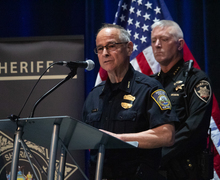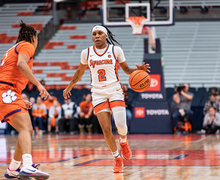Herman Frazier’s track to Syracuse ran from North Philly, through Olympic gold
Alexandra Moreo | Photo Editor
As senior deputy athletic director, Herman Frazier is responsible for most of the day-to-day functioning of SU Athletics, including forming the football schedule.
Herman Frazier’s world ranking as a sprinter was on the line. Then, the gun sounded. In his red top, blue short-shorts and white tube socks, he took off from the starting blocks for the first leg of the 4×400-meter final in the 1976 Montreal Olympics.
It was raining. But he couldn’t slow down. Down the backstretch, somehow, through the roar of 85,000 spectators, the 21-year-old heard his father’s voice alone from the stands, urging him to run even faster.
Frazier heeded the advice, handing the baton off in 45.3 seconds. He set the pace in what became a United States win by nearly three seconds.
He never ran another Olympic heat.
The U.S. boycotted the 1980 Moscow games, where, he said, he would have been favored to take the individual 400-meter gold. He’s been back several times, twice as the U.S. Olympic Committee’s vice president and as the Chef de Mission in 2004 at the Athens games.
Years later, on a Tuesday in mid-September in Manley Field House, Frazier’s left hand flashes with the bling he earned through his Olympic career.
“I’ve had two careers,” Frazier said.
His second gig brought him to Syracuse in 2011 as SU’s deputy athletic director and chief of staff. He now assembles head football coach Dino Babers’ schedule, approves complimentary ticket requests, handles discipline issues and runs just about all the day-to-day activity of SU Athletics. He likely wouldn’t be here, though, if it weren’t for his high-profile athletic career and the administrative work that began as a temporary solution to help him stay involved.
“The odds of me getting out getting out of North Philly probably were not good just because of the atmosphere back then, growing up in ‘60s and ‘70s,” he said. “I was just fortunate that I had parents who were there for me and stressed education all the way through my youth.”

Andy Mendes | Digital Design Editor
When Frazier was in 10th grade, his parents moved the family to Philadelphia’s outskirts in Germantown. He attended a school of about 3,500 students.
One day in gym class, the students did the high jump and Frazier jumped so high the school put him on the team. But, he played baseball, and the two sports overlapped. Students couldn’t do both — unless they’re good enough to never practice and only participate in the weekly meets.
Frazier was.
Germantown won a city championship during his junior year in 1971. The next season it hosted a trial day to see if any of its talented athletes were naturals in other events. Frazier finished his first 400-meter run in 58 seconds. It wasn’t an elite time, but with training, he had potential. With a season’s worth of it, he became a city champion.
Colleges, including Syracuse, offered Frazier scholarships, but he turned them down because he was “burned out” from school. He took a job earning $60 a week stocking at Strawbridge and Clothier in downtown Philadelphia. It took a few months for the high school graduate to rekindle his love of learning.
“You are an idiot,” he eventually told himself.
By February 1973, Frazier enrolled in Denison University, a small liberal arts school in Ohio. He arrived on a Monday, walked onto the team on Tuesday, ran with the quarter-milers on Wednesday and won a race on Saturday.
He was the best 400-meter runner in the Ohio Athletic Conference by the end of the season and qualified for the NCAA small-college division championships.
That summer, a high school coach connected Frazier with the Philadelphia Pioneer Club. The club, which had produced former world record-holders Ivory Crockett and Curtis Mills, took him to a meet in Gainesville, Florida. After a year running for the club, he qualified for a junior national team that went to Europe. His time of 46.6 seconds had people telling him he was good enough for the senior national team.
As running became more important to him, transferring from Denison became the clear move. Baldy Castillo’s program at Arizona State was the logical choice because it too consistently produced Olympic athletes; a Sun Devil had medaled at every games since 1952. During his redshirt year, Frazier trained with his ASU teammates during the week but flew to places like Madison Square Garden or Jamaica or Trinidad every weekend to run in the Pioneer Club’s amateur meets.
“The redshirt year probably helped me more than anything,” Frazier said.

Joe Bloss | Senior Staff Writer
By year’s end, Frazier was ready. He competed with the senior nationals at the World Championships in 1974 and at the PanAm games in 1975. Healthy again, qualifying for the Olympic team in Eugene, Oregon, came easily.
After his final year of NCAA eligibility in 1977, Frazier stayed at ASU and worked his way from graduate assistant to senior associate athletic director. At first, it was a chance to stay and train for the 1980 Olympics. But after the boycott, Frazier decided to move on and become the AD at Alabama-Birmingham in 2000. Frazier succeeded Gene Bartow, who became synonymous with the athletic department because he’d worked there for nearly all its existence.
Frazier fired Bartow’s son, Murry, as the men’s basketball coach. It was tough, Frazier said, but Murry’s replacement, Mike Anderson, led the Blazers to two Sweet 16 appearances before leaving for Missouri. Anderson is now the head coach at Arkansas.
Frazier’s Olympic background gave him an appreciation for the teams not playing revenue sports, he said. Marla Townsend was named UAB’s first softball coach in the program’s inaugural 2000 season just before Frazier arrived. She’s still at UAB today, in part because Frazier convinced the administration to outbid Indiana after the Hoosiers offered her a contract in 2002. It wasn’t his home, but he recognized it was hers.
“Even knowing he was leaving, he saw value in me staying here,” Townsend said.
That same summer, Frazier moved to Hawaii, a hire that fulfilled two objectives for UH, said Deane Neubauer, the then-interim chancellor of the university. At one angle, Frazier was someone they believed could add visibility to the football program. But he also “represented a perspective that was larger than that of island politics and island society,” Neubauer said.
Neubauer befriended Frazier. When they got together for dinner parties — and discussed their shared history as high school track athletes — Neubauer, a social scientist, saw what made Frazier so good at his job.
“He’s easy to get along with because he looks out into others to find places to respect them and to engage them,” Neubauer said.
Frazier’s many stops over the years have given him the thick rolodex he often takes advantage of now. He recalled a lunch with his current boss and former ESPN executive John Wildhack in Hawaii, where the two discussed how much the cable network wanted to air Hawaii’s consistently attractive games. It was that strength of schedule that helped Hawaii grow during Frazier’s tenure, Frazier said.
Frazier’s best deal, though, might have been the one he didn’t make. When USOC colleague and former Michigan AD Bill Martin thought about scheduling a 2007 opener against the Rainbow Warriors in Ann Arbor, Martin backed out because he didn’t want to take the chance of losing to a known threat in UH quarterback Colt Brennan. Instead, Martin scheduled Appalachian State, to which Michigan then infamously lost.
Meanwhile, Hawaii played two Division I-AA schools and went undefeated until meeting Matthew Stafford and Georgia in the 2008 Sugar Bowl.
“If you talk to people at Hawaii, I did nothing to help their football team,” Frazier joked.

Andy Mendes | Digital Design Editor
That’s because the national spotlight created a problem. Hawaii couldn’t afford to keep head coach June Jones, who left for Southern Methodist. With an upset fan base — the crowd once booed Frazier during a pregame ceremony at a basketball game — and an administration that didn’t hire him, Frazier was bought out of his contract. The island politics he was brought in to control ended up consuming him.
“You can do everything you want, but when somebody backs up the Brinks truck to their door, and you can’t match it or exceed it, you’re going to lose a coach,” said Bill Bradshaw, the AD who hired Frazier at Temple in 2008. The two knew each other from their days as ADs in Conference USA.
Bradshaw had multiple coaches that used Temple football as a stepping stone, including Frazier-aided hire Steve Addazio. Coaching searches are where Frazier’s network can be exploited. Bradshaw said Frazier would make calls to other conferences and schools to get the scoop on candidates. During his time there, Temple never hired a search firm.
“It was like having another Division I, FBS athletic director there,” Bradshaw said.
Former Syracuse AD Daryl Gross plucked Frazier from Temple in 2011. Frazier was promoted to senior deputy athletic director last year and is now working under his third AD, Wildhack.
The turnover, Frazier said, doesn’t do much to affect the job he’s most known for: the formation of SU’s football schedule. All it takes when a new regime rolls in is a meeting to make sure that he, the head coach and the AD are all on the same page. Football scheduling takes about one hour of work per week, because when Frazier calls someone, they answer.
The philosophy is all about balance. That’s why, in an Atlantic Coast Conference Atlantic Division that boasts perennial powerhouses, he must find respectable but beatable programs, like Connecticut last year and Army in the future. The end goal, as for every program, is to win enough to make it to a bowl.
More than four decades into the administrative career that nearly never was, one achievement stands out to Frazier. In 2006, the NCAA released a list its 100 most influential student-athletes. Jackie Robinson was number one. Dwight Eisenhower was number four. John Wooden and Vince Lombardi came in at No. 5 and 67, respectively. Below Earvin “Magic” Johnson was Herman R. Frazier, at No. 75.
“For the kid growing up in Philadelphia to eventually end up on that list,” Frazier said, “that doesn’t happen.”
Yet it did.
Published on October 2, 2017 at 12:17 am
Contact: [email protected] | @jtbloss




